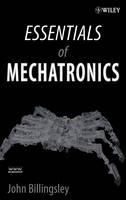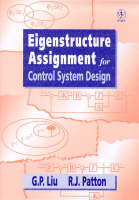Essentials of Mechatronics
 -15%
portes grátis
-15%
portes grátis
Essentials of Mechatronics
Billingsley, John
John Wiley & Sons Inc
07/2006
280
Dura
Inglês
9780471723417
15 a 20 dias
582
Descrição não disponível.
Preface. Acknowledgments.
1. Introduction.
1.1 A personal view.
1.2 What is and is not mechatronics.
2. The bare essentials.
2.1 Actuators.
2.2 Sensors.
2.3 Sensors for vision.
2.4 The computer.
2.5 Interface electronics for output.
2.6 Interface electronics for input.
2.7 Pragmatic control.
2.8 Robotics and kinematics.
3. Gaining Experience.
3.1 Getting to grips with QBasic.
3.2 The simplest mobile robot.
3.3 Ball and beam.
3.4 'Professional' position control.
3.5 An inverted pendulum.
4. Introduction to the Next Level.
4.1 The www.EssMech.com web site.
5. Electronic Design.
5.1 The rudiments of circuit theory.
5.2 The operational amplifier.
5.3 Filters for sensors.
5.4 Logic and latches.
6. Essential Control Theory.
6.1 State variables.
6.2 Simulation.
6.3 Solving the first-order equation.
6.4 Second order problems.
6.5 Modeling position control.
6.6 Matrix state equations.
6.7 Analogue simulation.
6.8 More formal computer simulation.
7. Vectors, Matrices and Tensors.
7.1 Meet the matrix.
7.2 More on vectors.
7.3 Matrix multiplication.
7.4 Transposition of matrices.
7.5 The unit matrix.
7.6 Coordinate transformations.
7.7 Matrices, notation and computing.
7.8 Eigenvectors.
8. Mathematics for Control.
8.1 Differential equations.
8.2 The Laplace transform.
8.3 Difference equations.
8.4 The z-transform.
8.5 Correlation and convolution.
9. Robotics, Dynamics and Kinematics.
9.1 Gears, motors and mechanisms.
9.2 Three dimensional motion.
9.2 Kinematic Chains.
9.3 Robot dynamics.
9.4 Simulating a robot.
10. Further Control Theory.
10.1 Control topology and non-linear systems.
10.2 Phase-plane methods.
10.3 Optimisation.
11. Computer Implementation.
11.1 Essentials of computing.
11.2 Software implications.
11.3 Embedded processors.
12. Machine Vision.
12.1 Vision sensors.
12.2 Acquiring an image.
12.3 Analyzing an image.
13. Case Studies.
13.1 Robocow - a mobile robot for training horses.
13.2 Vision guidance for tractors.
13.3 A shape recognition example.
14. The Human Element.
14.1 The user interface.
14.2 If all else fails, read the instructions.
14.3 It just takes imagination.
Index.
1. Introduction.
1.1 A personal view.
1.2 What is and is not mechatronics.
2. The bare essentials.
2.1 Actuators.
2.2 Sensors.
2.3 Sensors for vision.
2.4 The computer.
2.5 Interface electronics for output.
2.6 Interface electronics for input.
2.7 Pragmatic control.
2.8 Robotics and kinematics.
3. Gaining Experience.
3.1 Getting to grips with QBasic.
3.2 The simplest mobile robot.
3.3 Ball and beam.
3.4 'Professional' position control.
3.5 An inverted pendulum.
4. Introduction to the Next Level.
4.1 The www.EssMech.com web site.
5. Electronic Design.
5.1 The rudiments of circuit theory.
5.2 The operational amplifier.
5.3 Filters for sensors.
5.4 Logic and latches.
6. Essential Control Theory.
6.1 State variables.
6.2 Simulation.
6.3 Solving the first-order equation.
6.4 Second order problems.
6.5 Modeling position control.
6.6 Matrix state equations.
6.7 Analogue simulation.
6.8 More formal computer simulation.
7. Vectors, Matrices and Tensors.
7.1 Meet the matrix.
7.2 More on vectors.
7.3 Matrix multiplication.
7.4 Transposition of matrices.
7.5 The unit matrix.
7.6 Coordinate transformations.
7.7 Matrices, notation and computing.
7.8 Eigenvectors.
8. Mathematics for Control.
8.1 Differential equations.
8.2 The Laplace transform.
8.3 Difference equations.
8.4 The z-transform.
8.5 Correlation and convolution.
9. Robotics, Dynamics and Kinematics.
9.1 Gears, motors and mechanisms.
9.2 Three dimensional motion.
9.2 Kinematic Chains.
9.3 Robot dynamics.
9.4 Simulating a robot.
10. Further Control Theory.
10.1 Control topology and non-linear systems.
10.2 Phase-plane methods.
10.3 Optimisation.
11. Computer Implementation.
11.1 Essentials of computing.
11.2 Software implications.
11.3 Embedded processors.
12. Machine Vision.
12.1 Vision sensors.
12.2 Acquiring an image.
12.3 Analyzing an image.
13. Case Studies.
13.1 Robocow - a mobile robot for training horses.
13.2 Vision guidance for tractors.
13.3 A shape recognition example.
14. The Human Element.
14.1 The user interface.
14.2 If all else fails, read the instructions.
14.3 It just takes imagination.
Index.
Este título pertence ao(s) assunto(s) indicados(s). Para ver outros títulos clique no assunto desejado.
successful mechatronic product; mechatronics; nature; publication; essential; field; technology; engineering; crossroads; information; electrical; mechanisms; readers; functional design; breadth; mechatronics draws; critical
Preface. Acknowledgments.
1. Introduction.
1.1 A personal view.
1.2 What is and is not mechatronics.
2. The bare essentials.
2.1 Actuators.
2.2 Sensors.
2.3 Sensors for vision.
2.4 The computer.
2.5 Interface electronics for output.
2.6 Interface electronics for input.
2.7 Pragmatic control.
2.8 Robotics and kinematics.
3. Gaining Experience.
3.1 Getting to grips with QBasic.
3.2 The simplest mobile robot.
3.3 Ball and beam.
3.4 'Professional' position control.
3.5 An inverted pendulum.
4. Introduction to the Next Level.
4.1 The www.EssMech.com web site.
5. Electronic Design.
5.1 The rudiments of circuit theory.
5.2 The operational amplifier.
5.3 Filters for sensors.
5.4 Logic and latches.
6. Essential Control Theory.
6.1 State variables.
6.2 Simulation.
6.3 Solving the first-order equation.
6.4 Second order problems.
6.5 Modeling position control.
6.6 Matrix state equations.
6.7 Analogue simulation.
6.8 More formal computer simulation.
7. Vectors, Matrices and Tensors.
7.1 Meet the matrix.
7.2 More on vectors.
7.3 Matrix multiplication.
7.4 Transposition of matrices.
7.5 The unit matrix.
7.6 Coordinate transformations.
7.7 Matrices, notation and computing.
7.8 Eigenvectors.
8. Mathematics for Control.
8.1 Differential equations.
8.2 The Laplace transform.
8.3 Difference equations.
8.4 The z-transform.
8.5 Correlation and convolution.
9. Robotics, Dynamics and Kinematics.
9.1 Gears, motors and mechanisms.
9.2 Three dimensional motion.
9.2 Kinematic Chains.
9.3 Robot dynamics.
9.4 Simulating a robot.
10. Further Control Theory.
10.1 Control topology and non-linear systems.
10.2 Phase-plane methods.
10.3 Optimisation.
11. Computer Implementation.
11.1 Essentials of computing.
11.2 Software implications.
11.3 Embedded processors.
12. Machine Vision.
12.1 Vision sensors.
12.2 Acquiring an image.
12.3 Analyzing an image.
13. Case Studies.
13.1 Robocow - a mobile robot for training horses.
13.2 Vision guidance for tractors.
13.3 A shape recognition example.
14. The Human Element.
14.1 The user interface.
14.2 If all else fails, read the instructions.
14.3 It just takes imagination.
Index.
1. Introduction.
1.1 A personal view.
1.2 What is and is not mechatronics.
2. The bare essentials.
2.1 Actuators.
2.2 Sensors.
2.3 Sensors for vision.
2.4 The computer.
2.5 Interface electronics for output.
2.6 Interface electronics for input.
2.7 Pragmatic control.
2.8 Robotics and kinematics.
3. Gaining Experience.
3.1 Getting to grips with QBasic.
3.2 The simplest mobile robot.
3.3 Ball and beam.
3.4 'Professional' position control.
3.5 An inverted pendulum.
4. Introduction to the Next Level.
4.1 The www.EssMech.com web site.
5. Electronic Design.
5.1 The rudiments of circuit theory.
5.2 The operational amplifier.
5.3 Filters for sensors.
5.4 Logic and latches.
6. Essential Control Theory.
6.1 State variables.
6.2 Simulation.
6.3 Solving the first-order equation.
6.4 Second order problems.
6.5 Modeling position control.
6.6 Matrix state equations.
6.7 Analogue simulation.
6.8 More formal computer simulation.
7. Vectors, Matrices and Tensors.
7.1 Meet the matrix.
7.2 More on vectors.
7.3 Matrix multiplication.
7.4 Transposition of matrices.
7.5 The unit matrix.
7.6 Coordinate transformations.
7.7 Matrices, notation and computing.
7.8 Eigenvectors.
8. Mathematics for Control.
8.1 Differential equations.
8.2 The Laplace transform.
8.3 Difference equations.
8.4 The z-transform.
8.5 Correlation and convolution.
9. Robotics, Dynamics and Kinematics.
9.1 Gears, motors and mechanisms.
9.2 Three dimensional motion.
9.2 Kinematic Chains.
9.3 Robot dynamics.
9.4 Simulating a robot.
10. Further Control Theory.
10.1 Control topology and non-linear systems.
10.2 Phase-plane methods.
10.3 Optimisation.
11. Computer Implementation.
11.1 Essentials of computing.
11.2 Software implications.
11.3 Embedded processors.
12. Machine Vision.
12.1 Vision sensors.
12.2 Acquiring an image.
12.3 Analyzing an image.
13. Case Studies.
13.1 Robocow - a mobile robot for training horses.
13.2 Vision guidance for tractors.
13.3 A shape recognition example.
14. The Human Element.
14.1 The user interface.
14.2 If all else fails, read the instructions.
14.3 It just takes imagination.
Index.
Este título pertence ao(s) assunto(s) indicados(s). Para ver outros títulos clique no assunto desejado.




